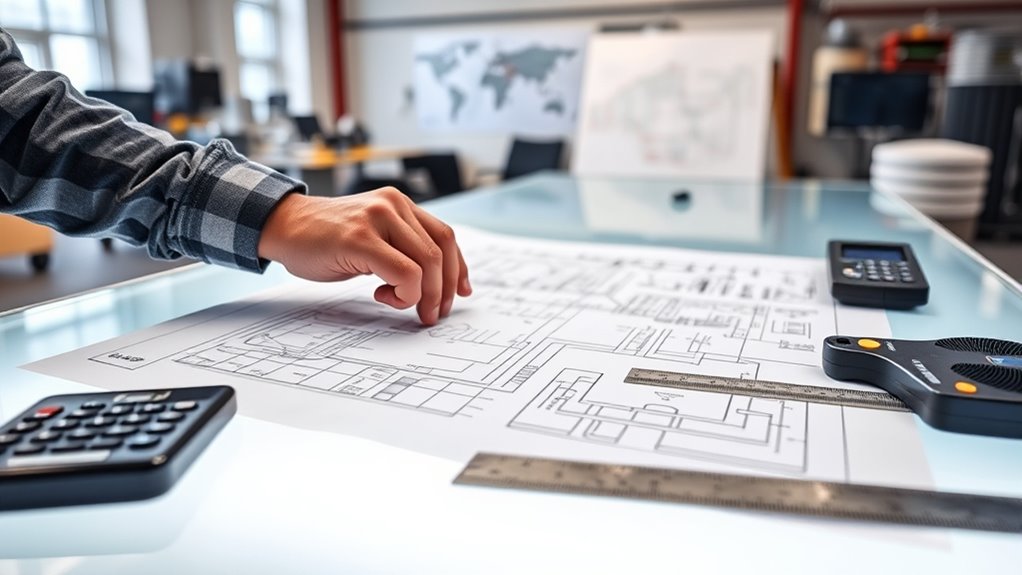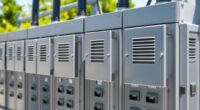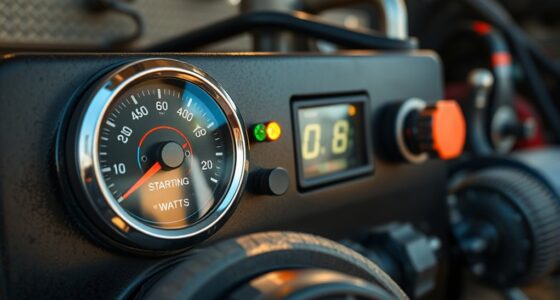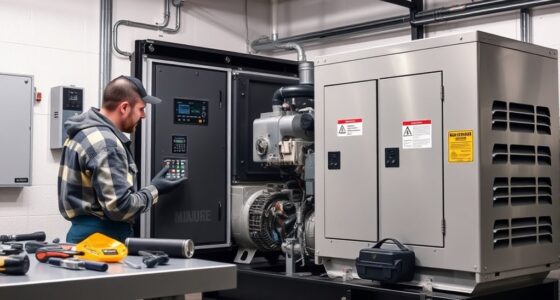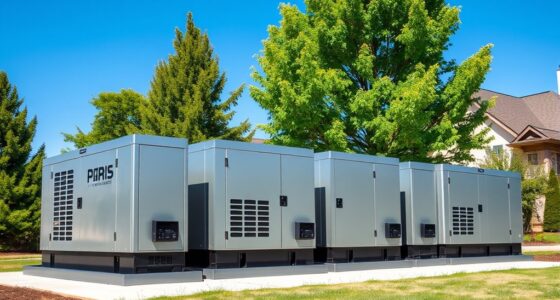To size heat pumps and well pumps correctly, you need to accurately assess your home’s heating and cooling loads, considering insulation, window placement, and seasonal changes. For well pumps, determine your household’s peak water demand based on fixture use and flow needs. Proper calculations prevent energy waste and system failures. If you want to guarantee peak performance and efficiency, understanding these vital steps can make all the difference; keep going to learn how to do them right.
Key Takeaways
- Conduct detailed load calculations considering home size, insulation, climate, and internal heat sources to determine accurate heat pump sizing.
- Measure room dimensions and assess window placement and insulation quality for precise cooling and heating load estimation.
- Evaluate household water usage patterns and fixture counts to correctly size well pumps for peak demand and flow requirements.
- Use professional load calculation tools or software to incorporate variables like seasonal variations, insulation, and occupancy for optimal sizing.
- Regularly verify equipment performance and adjust sizing as needed to prevent short cycling, energy waste, or insufficient comfort.
Understanding Your Home’s Heating and Cooling Loads

To properly size a heat pump or well pump, you first need to understand your home’s heating and cooling loads. Your thermostat settings play a key role here, as they influence how much energy your system uses throughout the year. During colder months, your heating load increases, while in warmer seasons, your cooling needs rise. Seasonal variations affect how your home responds to outdoor temperatures, so knowing these fluctuations helps you choose the right equipment size. If your thermostat is set very high or low, it can cause your system to work harder than necessary, impacting efficiency. By tracking how your heating and cooling demands change with seasons, you’ll gather the essential information needed for accurate sizing. Additionally, considering the noise levels of modern heat pumps can help ensure your system operates quietly and comfortably year-round without overworking or underperforming.
Calculating the Heating Load for Your Space

To accurately calculate your heating load, start by checking how well your insulation performs. You also need to determine the size of each room to understand how much heat is needed. These factors help make sure your heat pump or well pump is properly matched to your space. Incorporating energy-efficient features can further optimize heating performance and reduce overall energy consumption.
Assessing Insulation Effectiveness
Evaluating insulation effectiveness is essential for accurately calculating your space’s heating load. Different insulation types offer varying levels of thermal resistance, which directly impact heat retention. To assess this, examine the materials used—fiberglass, foam, or cellulose—and their R-values, indicating how well they resist heat flow. Higher R-values mean better insulation and reduced heat loss. Check for gaps, compression, and proper installation, as these can compromise insulation performance. Consider the age and condition of existing insulation, since degraded or outdated materials may no longer provide adequate thermal resistance. By understanding the insulation’s quality and how it limits heat transfer, you’ll gain a clearer picture of your space’s heating needs, ensuring you select a system that maintains comfort efficiently.
Determining Room Size
Accurately determining your room size is a crucial step in calculating the appropriate heating load for your space. Measure the length and width of each room, then multiply them to find the square footage. Don’t forget to account for window placement, as large or south-facing windows can increase heat loss or gain, affecting your heating needs. Aesthetic considerations also matter; the room’s layout and design can influence insulation and airflow, impacting the overall load calculation. Keep in mind that high ceilings or open floor plans might require adjustments to your calculations. Additionally, understanding the Prairie scenery of your area can help inform insulation choices and energy efficiency strategies. By precisely measuring your space and considering these factors, you’ll ensure your heat pump matches your room’s heating requirements, maximizing efficiency and comfort.
Determining the Cooling Load Requirements

To determine your cooling needs, start by calculating the heat gain from your space. You’ll also need to assess internal factors like appliances, lighting, and occupancy. Understanding these points helps make sure your system is sized accurately for comfort and efficiency. Incorporating principles of Design Thinking can further help you develop tailored solutions that meet your specific needs.
Calculating Heat Gain
Understanding how to calculate heat gain is vital for determining your cooling load requirements. You need to identify sources of heat entering your space, including sunlight through windows, appliances, lighting, and occupancy. Accurately estimating heat gain helps you maintain thermal comfort without overcooling, which wastes energy. Focus on calculating both internal and external heat sources to get a clear picture of your cooling needs. Additionally, considering remote work practices can influence your home’s heating and cooling demands, especially if you spend more time at home. By understanding these factors, you can select appropriately sized equipment that conserves energy and provides consistent comfort. Proper heat gain calculation ensures your cooling system is efficient, effective, and aligned with energy conservation goals. This step is essential for designing a system that meets your comfort demands without unnecessary energy consumption.
Assessing Internal Factors
Once you’ve identified the sources of heat gain, the next step is to assess the internal factors that influence your cooling load. Your thermostat placement plays a pivotal role; an ideal spot ensures accurate temperature readings and consistent comfort. Poor placement can cause your system to work harder, increasing energy use. Additionally, duct system efficiency impacts cooling needs considerably. Leaky or poorly insulated ducts can lose cooled air, forcing your system to run longer and harder. Inspect your ductwork for leaks, obstructions, and insulation quality. By optimizing thermostat placement and improving duct efficiency, you can better match your cooling system’s capacity to your home’s actual requirements, ensuring comfort while minimizing energy consumption. Proper system calibration also helps in maintaining an optimal cooling load, preventing unnecessary strain on your equipment.
Assessing Well Pump Flow Rate Needs
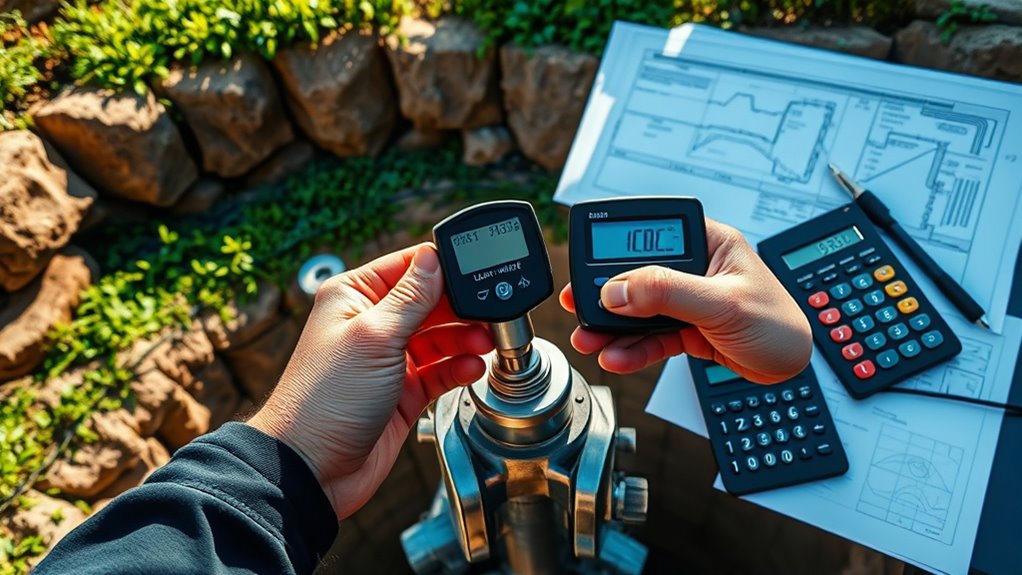
When evaluating well pump flow rate needs, it’s vital to determine how much water your household consumes daily. This helps you estimate the well flow your pump must support. First, track your family’s average daily water use. Second, consider peak usage times, like mornings or evenings. Third, identify the number of fixtures and appliances drawing water simultaneously. Fourth, make certain the pump capacity matches the highest expected demand to prevent pressure drops. Fifth, choosing a vetted pump brand can ensure durability and performance under your household’s specific requirements. Accurate assessment of well flow ensures your pump can handle your household’s needs without overworking or underperforming. Remember, selecting the right pump capacity prevents issues like low water pressure and pump failure, making your system more efficient and reliable. Properly assessing flow rate needs is essential for a well-functioning water system.
Estimating the Well Pump’s Required Capacity
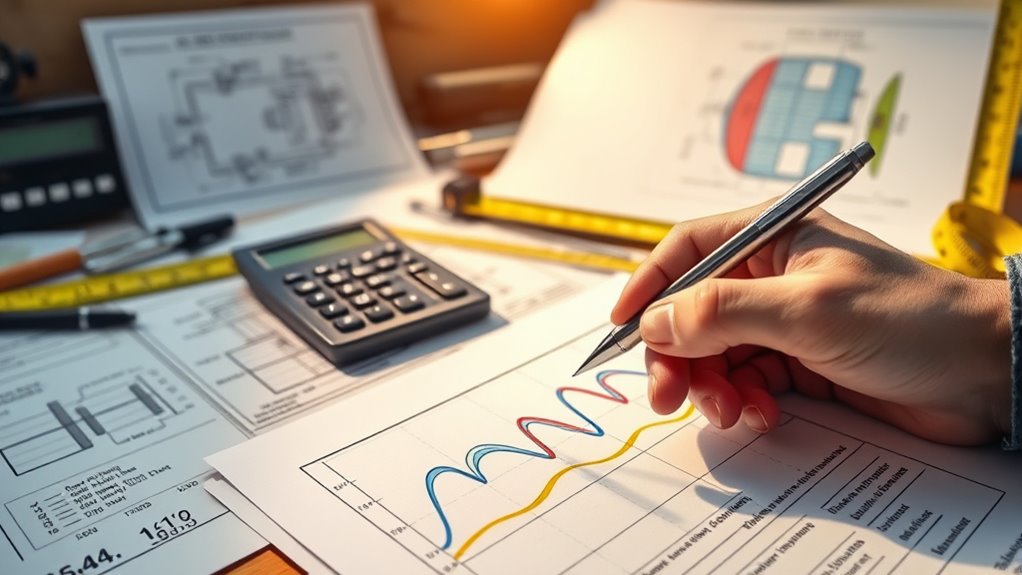
Estimating the well pump’s required capacity involves calculating your household’s peak water demand to guarantee the pump can meet your needs without strain. To do this accurately, consider your household’s daily water usage and peak usage times, ensuring the pump can handle these demands comfortably. Keep in mind the aquifer capacity, which influences how much water is accessible without depleting the source. A pump that’s too powerful risks overtaxing the aquifer and reducing its lifespan. Conversely, an undersized pump can struggle to keep up, leading to frequent cycling and wear. Proper capacity estimation helps choose a pump with adequate pump durability, ensuring it operates efficiently and lasts longer, providing reliable water supply while safeguarding your aquifer. Additionally, understanding the effectiveness of eye patches can be useful if you’re considering quick aesthetic solutions during routine maintenance or downtime.
Selecting the Appropriate Heat Pump Size
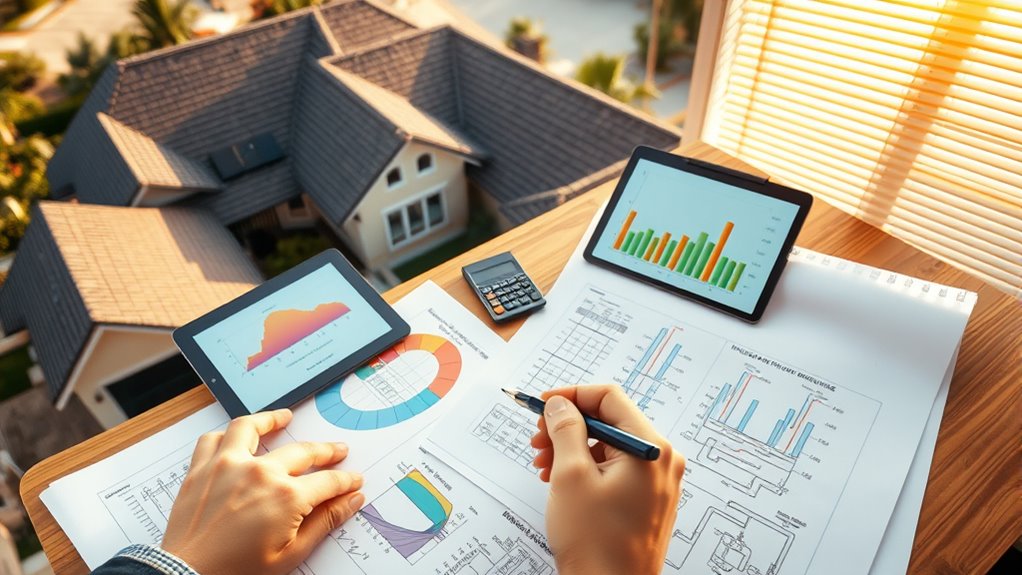
Choosing the right size for your heat pump starts with understanding your home’s heating and cooling needs. Proper sizing ensures comfort and efficiency, preventing short cycling or inadequate heating. To select the right unit, consider these steps:
- Assess your home’s square footage and insulation quality.
- Review your thermostat settings and preferred comfort levels.
- Account for seasonal variations that affect heating and cooling demands.
- Consult load calculation tools or professionals for precise sizing.
- Recognize the importance of accurate load assessment in selecting the most efficient system.
Avoid relying solely on the manufacturer’s capacity ratings; instead, factor in your home’s specific conditions. Oversized units cycle on and off frequently, wasting energy, while undersized units struggle to maintain comfort. Accurate sizing balances these factors, optimizing performance across seasonal changes.
Evaluating Pump Efficiency and Energy Use
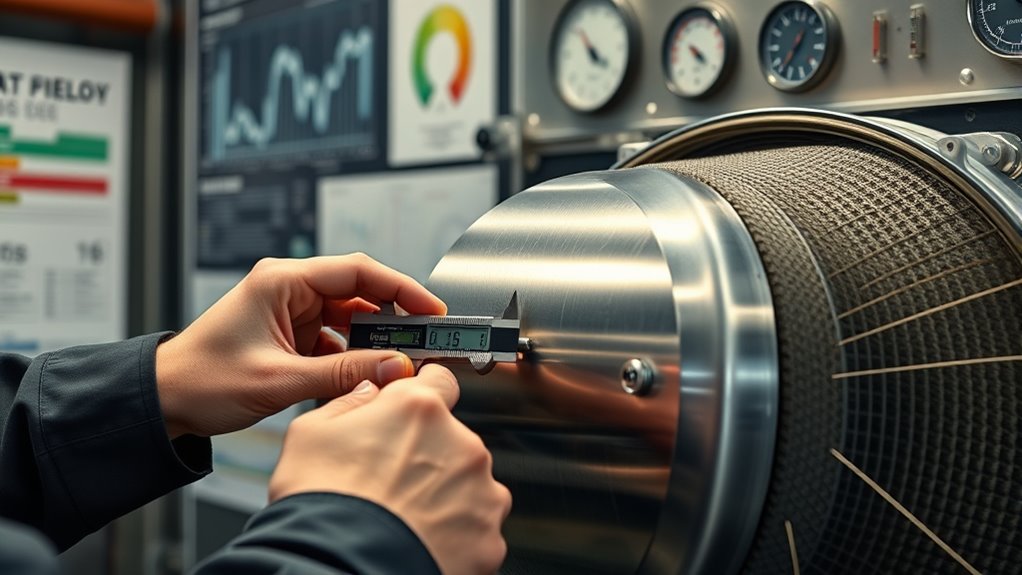
Evaluating the efficiency and energy consumption of your pump is essential to guarantee it operates effectively and cost-efficiently. Start by examining the pump motor’s performance, focusing on its energy efficiency rating. A high-efficiency pump motor uses less electricity to deliver the same flow, reducing operating costs. Check the motor’s power consumption against its output to identify any inefficiencies. Regular maintenance, like cleaning and lubricating components, also helps assure optimal energy use. Consider monitoring your pump’s runtime and energy bills to gauge ongoing efficiency. If you notice excessive energy use or irregular performance, it might indicate the need for a more efficient pump motor. Proper evaluation ensures your well pump runs smoothly while keeping energy costs in check. Additionally, Ford Tuning techniques can be applied to optimize the overall performance and longevity of your pump system.
Accounting for Future Expansion and Variations

When planning for heat pumps and well pumps, it’s crucial to take into account how your system might need to adapt to future expansion or changes in demand. Considering future growth ensures your system remains efficient as your needs evolve. To maintain system flexibility, think about:
- Installing slightly larger capacity equipment to accommodate potential demand increases
- Designing for modular system expansion, allowing upgrades without complete replacement
- Choosing adaptable control systems that can be scaled or reconfigured
- Planning for additional well capacity or additional heat pump units if needed later
Verifying Calculations With Professional Tools and Guidance
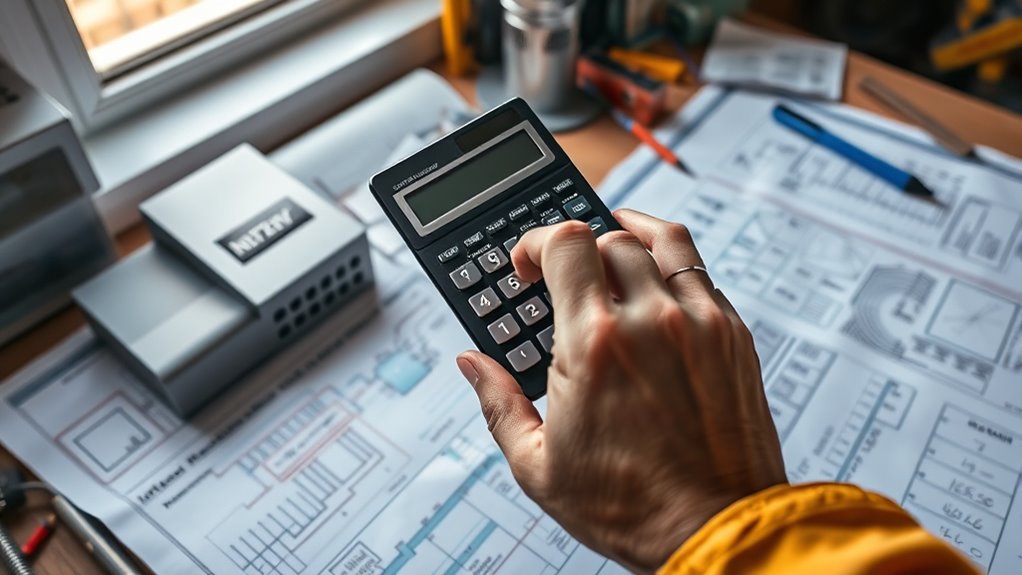
After planning for future expansion, it’s important to verify your calculations with professional tools and guidance. Accurate sizing ensures ideal thermal comfort and maximizes energy savings. Professional tools, like load calculation software and thermal modeling programs, provide precise assessments of your system’s capacity needs. These tools account for variables such as climate, insulation, and usage patterns, reducing guesswork. Consulting with experts ensures your calculations align with industry standards and local codes. Proper verification helps prevent under- or over-sizing, which can lead to inefficient operation, higher energy costs, and compromised comfort. Using professional guidance not only enhances system performance but also safeguards your investment, giving you confidence that your heat pump or well pump is correctly sized for your specific needs.
Frequently Asked Questions
How Often Should I Re-Evaluate My Heat Pump Size?
You should re-evaluate your heat pump size every 3 to 5 years to ensure maximum energy efficiency. Regular maintenance tips, like cleaning filters and checking ducts, help identify if your system is still suitable. Changes in your home’s insulation or size can affect performance, so staying proactive ensures your heat pump operates efficiently and saves you money on energy costs. Don’t wait until issues arise—periodic assessments keep your system in top shape.
Can Incorrect Sizing Cause System Failures or Increased Costs?
Incorrect sizing can definitely cause system failures and increased costs. When your heat pump or well pump is too small, it strains to meet your needs, reducing system efficiency and increasing wear and tear. When it’s too large, you face higher installation costs and unnecessary energy use. Proper sizing guarantees ideal system efficiency, reduces repair risks, and minimizes installation costs, helping you save money and enjoy reliable performance.
What Impact Does Climate Change Have on Sizing Calculations?
Climate change impacts your sizing calculations by increasing temperature variability and forcing you to contemplate climate adaptation. As temperatures become less predictable, you must account for more extreme weather patterns and fluctuating seasonal demands. This means sizing heat pumps and well pumps more conservatively, ensuring they can handle higher or lower temperatures effectively. Properly adjusting for climate change helps prevent system failures and maintains efficiency amid changing environmental conditions.
How Do Local Building Codes Influence Sizing Decisions?
Local building codes heavily influence your sizing decisions by requiring building code compliance, which guarantees safety and efficiency. You’ll need to take into account permits and inspections before installation, as these processes confirm your system meets local standards. Failing to adhere to codes can lead to fines or system rejection, so it’s crucial to review regulations early. Properly following these rules helps you avoid costly adjustments and ensures your heat or well pump operates effectively.
Are There Specific Tools Recommended for DIY Sizing Assessments?
You can use manual tools like calculators or charts for basic sizing assessments, but software programs offer more accuracy. Programs such as HVAC design software or specialized sizing tools help you input specific data and get precise results quickly. While manual tools are handy for quick estimates, software guarantees you consider all variables, making your sizing decisions more reliable and efficient. Always double-check with local codes for compliance.
Conclusion
By carefully crunching the numbers, you guarantee your heat pump and well pump are perfectly sized, preventing costly mistakes and inefficiencies. Don’t forget to double-check your calculations with professional tools—think of it as having a trusty compass on a treacherous sea. Proper sizing might seem like a task from the days of quill and parchment, but it’s your best bet for reliable, energy-efficient comfort all year round. Stay diligent—you’ll thank yourself later.
